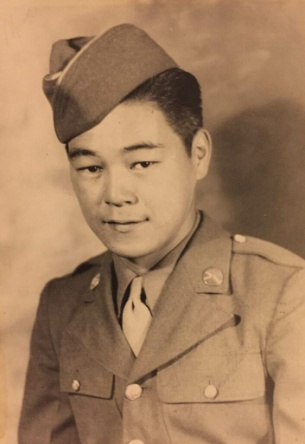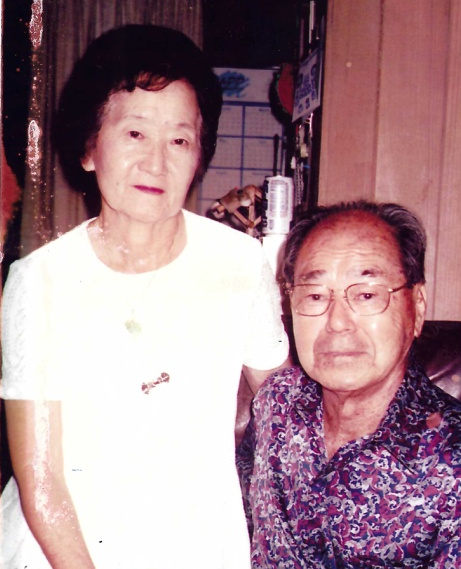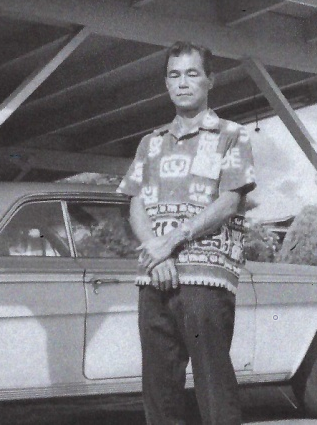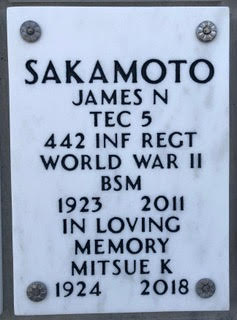
James Naomitsu Sakamoto
Technician 5th Grade
442nd Regimental Combat Team
2nd Battalion, Headquarters Company
James Naomitsu Sakamoto was born on March 7, 1923, in Honolulu, Territory of Hawaii. He was the fourth child of Busuke and Kiyono (Orikasa) Sakamoto. His siblings were brothers George J., Kazuo, and Robert Nobuaki; sisters Edith Teruyo, Jean Mitsue, Florence Kimie, and Ethel Fumie.
His parents were from the village of Mitomi, district of Higashiyamanashi, Yamanashi Prefecture, Japan. Busuke arrived on January 19, 1907, on the America Maru. Kiyono arrived on the Seattle Maru on October 27, 1916.
In 1930, the family lived on Waikahalulu Lane in the Nuuanu area of Honolulu. Father Busuke was a truck driver for a house construction business. By 1940, he was the proprietor of an express delivery company.
Naomitsu attended McKinley High School where he became known as “Jimmy.” His teacher could not say “Naomitsu” and proclaimed that he would call him Jimmy. Years later, Jimmy would legally adopt James as his first name.
James Naomitsu Sakamoto graduated from McKinley High School in 1941. He worked at Lewers and Cooke and attended Honolulu Business College before the war.
James signed his Draft Registration card on June 30, 1942, Local Board No. 6, at the National Guard Armory. His point of contact was Charles Imamura of 144 Desha Lane. He was 5’5” tall and weighed 115 pounds, and he was employed by Lewers & Cooke, Ltd. in Honolulu.
Sakamoto enlisted into the U.S. Army on March 30, 1943. He was sent to the “tent city” at Schofield Barracks with the other new soldiers. They left Honolulu on April 4 on the S.S. Lurline for San Francisco. This was followed by a cross county train trip to Camp Shelby, Mississippi.
There, the Nisei soldiers underwent basic training, specialized training, and field maneuvers. Jimmy was a member of the Radio Section of the Communication Platoon of Headquarters Company, 2nd Battalion, 442nd Regimental Combat Team.
A buddy of Jimmy’s later wrote:
During training at Camp Shelby, Jimmy became a favorite of our battalion commander, Lt. Col. James Hanley. When Hanley wrote his memoir, he spoke of the time he had Jimmy ask a farmer to move his herd of cows across a bridge during maneuver training, then the 2nd Battalion crossed over. The Army Inspector said the 2nd Battalion was “killed” in crossing the bridge, which had been mined. Hanley told the Inspector, “The cows detonated the mines,” and that there was “lots of meat for hamburgers now.” The Army Inspector had no answer for that.
Somehow, Lt. Col. Hanley became a great friend of the Communication Platoon. He remembers many of them besides Jimmy – persons such Titi Yonemori, who had the wire spools increased to more than double the length of the wires for the field phones. In fact, the first Silver Star award of the 2nd Battalion Headquarters Company was to Noboru Togioka of the Communication Platoon, who did his work under enemy fire.
After nearly a year, the Combat Team left Camp Shelby by train on April 22, 1944, for Camp Patrick Henry, Virginia. On May 2, they left from nearby Hampton Roads in a large convoy of troop ships enroute to the Mediterranean Theater of Operations. The 442nd arrived at Naples, Italy, on May 28. However, the ship that carried most of 2nd Battalion left the convoy and headed for port in Oran, Algeria. After offloading cargo, they rejoined the regiment in Italy on June 17.
The 442nd entered combat in the Rome-Arno Campaign on June 26, 1944, near Suvereto. According to one of his friends, Jimmy’s Communication Platoon was always in danger from enemy fire as their duty was ensuring that frontline actions were coordinated with the battalion Command Post.
The 442nd left Italy on September 27 for Marseilles, France, to join in the Rhineland-Vosges Campaign. On arrival in Marseilles, the Combat Team was in a bivouac area in nearby Septèmes until October 9, when they were transported north to join the battle in the Vosges Mountains. In October-November, the 442nd liberated the important road junction of Bruyères, followed by Biffontaine, and the famous “Rescue of the Lost Battalion” – the 1st Battalion of the 141st (Texas) Infantry Regiment that had advanced beyond its support, become surrounded by the enemy, and was unable to extricate itself.
As a Corporal during this time, Sakamoto was awarded the Bronze Star Medal for action on October 17, 1944, for “maintaining constant communication between advancing rifle companies and the rear command post of his battalion, although frequently subjected to enemy fire.”
After the intense and costly battles in the Vosges Mountains, the 442nd left on November 19 by truck convoy for southern France. They remained in the area of Nice and Menton on the coast and Sospel and Peira Cava in the mountains for several months – this was the Rhineland-Maritime Alps Campaign.
On March 20-22, 1945, the 442nd returned to Italy for the Po Valley Campaign. In the early part of April, the Combat Team set off in the mountainous area of the west coast of northern Italy with the mission of cracking the western anchor of the Gothic Line. In what was ordered as a diversionary attack to draw off critical German army units from the Gothic Line center, the 442nd RCT rapidly crushed the German defenses, and continued on the attack, turning the planned diversion into a full-scale breakthrough of the vaunted Gothic Line, liberating the west of Italy all the way to Turin.
During these rapidly moving battles, Tec/5 Sakamoto earned a second Bronze Star Medal for his actions near Mt. Belvedere and Castelpoggio. The Citation stated that:
…[he supplied] communications each time wire communications were broken by enemy fire. Many times under hostile artillery and mortar barrages, he voluntarily stationed himself in exposed positions to maintain communications. For three successive days, in the vicinity of Mt. Belvedere, Italy, he operated his radio without relief.
The Citation continued to state that in mid-April near Castelpoggio, he personally captured an enemy artillery liaison officer hidden in a cemetery, though armed with only a pistol.” This Bronze Star was presented in September 1945, during the occupation that followed the end of the war in Europe on May 8.
For his military service, Tec/5 Naomitsu Sakamoto received the following decorations: Bronze Star Medal with two oak leaf clusters, Good Conduct Medal, American Campaign Medal, European-African-Middle Eastern Campaign Medal with four bronze stars, World War II Victory Medal, Army of Occupation Medal, Combat Infantryman Badge, and Distinguished Unit Badge.
He was awarded the Congressional Gold Medal on October 5, 2010, along with the other veterans of the 100th/442nd Regimental Combat Team. This is the highest Congressional Civilian Medal.
In 2010, Sakamoto’s 442nd buddy wrote the following tribute:
… we called ourselves the AJAs – Americans of Japanese Ancestry. Today, we are called the Nisei by everyone, including our French friends. We earned this distinction the hard way.
It’s unfortunate that Jimmy won’t be here when the Congressional Gold Medal is presented to the 442nd…Replicas of this…Medal will be presented at ceremonies in Washington DC in November; and here in Honolulu in December to the veterans in attendance. From being called “enemy aliens” to receiving the Nation’s highest civilian award is an enormous step…The Sakamoto family can always be proud of Jimmy’s 442nd service.
Tec/5 James N. Sakamoto arrived home on December 19, 1945, on the USAT Evangeline. He was among the 567 war veterans on the ship that docked at Pier 24 in Honolulu. After they disembarked, friends and family were allowed to visit for one hour on the dock. Then the soldiers were sent on Army trucks to the Oahu Personnel Center at Fort Kamehameha for processing prior to their discharge at a later date. Sakamoto was discharged on January 5, 1946, at an Army Separation Center on Oahu.
The following tribute was written by the Sakamoto family:

After the War, James attended the RCA Institute in New York for one year where he studied radio and electronics. He worked again at Lewers and Cooke. With marriage on the horizon…he switched to life insurance with Occidental to make a little money. Then in 1950, he started his career in radio and electronics at Pearl Harbor Naval Shipyard Shop 67. He retired as a quarterman from Pearl Harbor in 1979.
Jimmy was introduced to his lifelong partner by his good friend, Tomio Otsu. Tomio was a Konowaena school classmate of Mitsue Kaneko, or “Mi-Chan,” as she was lovingly called.
Right: Jimmy and Mitsue in later years
They were married on June 25, 1949, and celebrated 62 years of marriage. Together, they raised four children – sons Dale and Alan, and daughters Lynn and Amy, on Waikahalulu Lane in Nuuanu, where Jimmy had grown up. In 1957, they moved to Pearl City, where he was active in the community, especially as a Little League Coach for his sons’ teams.

Jimmy loved cars. He loved Volkswagens. So much so that he set up his garage to fix Volkswagens. He fixed Dale’s Volkswagen, Lynn’s Volkswagen, Alan’s Volkswagen, and he fixed cousin Verne’s Volkswagen. His true love of cars was his Chevys. He had a ‘51 Chevy, but his greatest passion was his ’62 Impala. He loved to work on that car.
Left: Jimmy with his 1962 Impala
Jimmy was a study in the evolution of compassion. As a father, he made the transformation from a harsh disciplinarian who expected perfection to a loving, unconditionally supportive family man who enjoyed sharing in the adventures and exploits of his eight grandchildren. We also know his spirit is alive and well in his three great-grandsons – James, named after him; Jackson; and Shane!
James Naomitsu Sakamoto, showed us how to live and enjoy life even in the face of adversity. He always found a way. Until his passing, he lived and enjoyed life to the fullest!

James Naomitsu Sakamoto died on August 5, 2011. He was inurned in the Columbarium at the National Memorial Cemetery of the Pacific at Punchbowl, Section C12-S, Row 400, Site 467. He was survived by his wife, four children, eight grandchildren, and one sister. His wife was later inurned with him. Their marble niche plate is inscribed In Loving Memory.
Researched and written by the Sons & Daughters of the 442nd Regimental Combat Team with assistance by the Sakamoto family in 2021.
